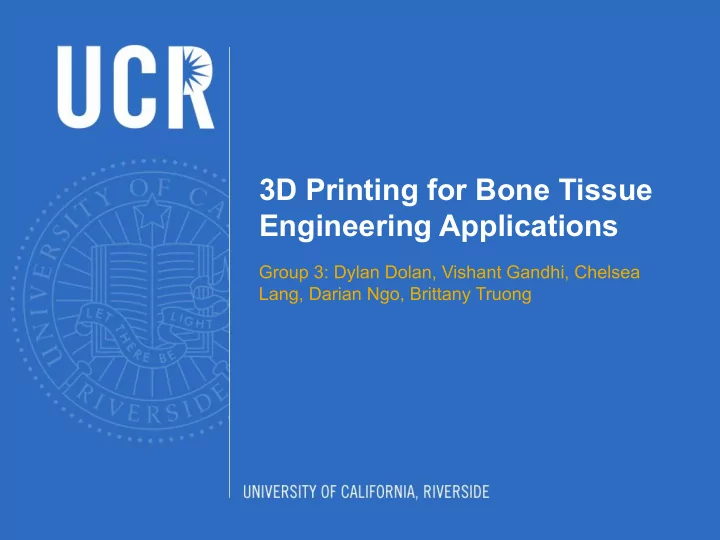

3D Printing for Bone Tissue Engineering Applications Group 3: Dylan Dolan, Vishant Gandhi, Chelsea Lang, Darian Ngo, Brittany Truong
Outline I. Problem II. Objective III. Previous Studies IV. Proposed Development A. Design Criteria B. Synthesis and Fabrication C. Experiment V. Concluding Remarks
Outline I. Problem II. Objective III. Previous Studies IV. Proposed Development A. Design Criteria B. Synthesis and Fabrication C. Experiment V. Concluding Remarks
Problem ● There are 1.3 million surgeries for bone damage annually ● Most common broken bone is the clavicle ● Most Common type of break is a fracture
Problem ● Traditional scaffold manufacturing methods ○ Electrospinning ■ Use of electrical charge to create nonwoven scaffolds ○ Solvent Casting ■ Dissolution of polymer-ceramic particle mixture ○ Freeze Drying ■ Synthetic polymer is dissolved then poured into moulds with liquid Nitrogen
Outline I. Problem II. Objective III. Previous Studies IV. Proposed Development A. Design Criteria B. Synthesis and Fabrication C. Experiment V. Concluding Remarks
Objective Use 3D Printing with Hydrogel Composites ● Low cost ● Rapid manufacturing of personalized scaffolds ● Potentially solve donor shortage problem
Outline I. Problem II. Objective III. Previous Studies IV. Proposed Development A. Design Criteria B. Synthesis and Fabrication C. Experiment V. Concluding Remarks
Previous Studies ● 3D printed collagen scaffolds ○ Direct-write printing ○ Adjustable variables ○ Created 104 customized layers ● 3D printed ceramic and composite scaffolds ○ Inkjet printing ○ Freedom to vary porosity ○ Achieved close mechanical strength of cortical bone ■ Experimental: 122 MPa ■ Cortical: 100-150 MPa [1] Smith CM, Christian JJ, Warren WL, Williams SK. Characterizing Environmental Factors that Impact the Viability of Tissue-Engineered Constructs Fabricated by a Direct-Write Bioassembly Tool. Tissue Engineering. 2007;13(2)373-383 [2] Roohani-Esfahani SI, Newman P, Zreiqat. Design and Fabrication of 3D printed Scaffolds with a Mechanical Strength Comparable to Cortical Bone to Repair Large Bone Defects. Sci Rep. 2016;6:1-8
Outline I. Problem II. Objective III. Previous Studies IV. Proposed Development A. Design Criteria B. Synthesis and Fabrication C. Experiment V. Concluding Remarks
Design Criteria ● Biocompatibility ● Biodegradability ● Pore interconnectivity, pore size, and porosity ● Mechanical properties similar to natural human bone ● None/minimized inflammatory response
Synthesis & Fabrication Biomaterial Selection ● Bioceramics ○ Nano-Hydroxyapatite ● Polymer/Protein ○ Fibroin Tozzi G, De Mori A, Oliveira A, Roldo M. Composite Hydrogels for Bone Regeneration. Materials (Basel) . 2016;9(4):267. Published 2016 Apr 2. doi:10.3390/ma9040267
Synthesis & Fabrication
Synthesis & Fabrication Stereolithography (SLA) Printer
Experiment ● In Vitro ○ A test within a cell culture ○ 3D print scaffold and implant it with a cell culture ● In Vivo ○ A test within a live subject such as an animal ○ Apply for IACUC approvals ○ Obtain female rats and induce fracture with anesthetics and immune suppressors
Outline I. Problem II. Objective III. Previous Studies IV. Proposed Development A. Design Criteria B. Synthesis and Fabrication C. Experiment V. Concluding Remarks
Concluding Remarks ● Limitations ○ Though 3D printing materials have low stability and take lots of time to make ○ Nano-HA is printable but it is quite hard to make ■ Would require surface modifications to make it: ● Adhere, Proliferate, & Grow better ■ This would allow us to increase biocompatibility and osteoplastic potential ○ Fibroin as a polymer is beneficial but has drawbacks ■ There aren't enough modifiable amino acid side chain groups compared to other collagens or scaffolds Do, Anh-Vu et al. “3D Printing of Scaffolds for Tissue Regeneration Applications.” Advanced healthcare materials vol. 4,12 (2015): 1742-62. doi:10.1002/adhm.201500168 V V Minaychev et al. “Limitation of biocompatibility of hydrated nanocrystalline hydroxyapatite” IOP Conf. Series: Materials Science and Engineering 347 (2018) 012045 doi:10.1088/1757-899X/347/1/012045 Vepari, Charu, and David L Kaplan. “Silk as a Biomaterial.” Progress in polymer science vol. 32,8-9 (2007): 991-1007. doi:10.1016/j.progpolymsci.2007.05.013
Concluding Remarks ● Future Works ○ Change the ratio of nano-HA/polymer (or protein) ○ Change the polymer or protein ○ Improve 3D printing resolution ○ Reduce post processing work
Questions?
Contributions Dylan: Significance of Problem Vishant: Experiment & Limitations Chelsea: Objective, Design Criteria Brittany: Previous Studies Darian: Synthesis & Fabrication, Future Work
Recommend
More recommend